The ASUS TUF X99 Sabertooth Review
by Ian Cutress on July 22, 2015 10:00 AM EST- Posted in
- Motherboards
- Asus
- TUF
- X99
CPU Performance
Readers of our motherboard review section will have noted the trend in modern motherboards to implement a form of MultiCore Enhancement / Acceleration / Turbo (read our report here) on their motherboards. This does several things, including better benchmark results at stock settings (not entirely needed if overclocking is an end-user goal) at the expense of heat and temperature. It also gives in essence an automatic overclock which may be against what the user wants. Our testing methodology is ‘out-of-the-box’, with the latest public BIOS installed and XMP enabled, and thus subject to the whims of this feature. It is ultimately up to the motherboard manufacturer to take this risk – and manufacturers taking risks in the setup is something they do on every product (think C-state settings, USB priority, DPC Latency / monitoring priority, memory subtimings at JEDEC). Processor speed change is part of that risk, and ultimately if no overclocking is planned, some motherboards will affect how fast that shiny new processor goes and can be an important factor in the system build.
For clarification, the X99 Sabertooth does not have MultiCore Turbo enabled by default.
Point Calculations – 3D Movement Algorithm Test: link
3DPM is a self-penned benchmark, taking basic 3D movement algorithms used in Brownian Motion simulations and testing them for speed. High floating point performance, MHz and IPC wins in the single thread version, whereas the multithread version has to handle the threads and loves more cores. For a brief explanation of the platform agnostic coding behind this benchmark, see my forum post here.
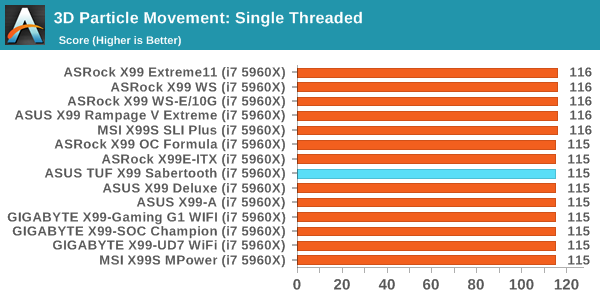
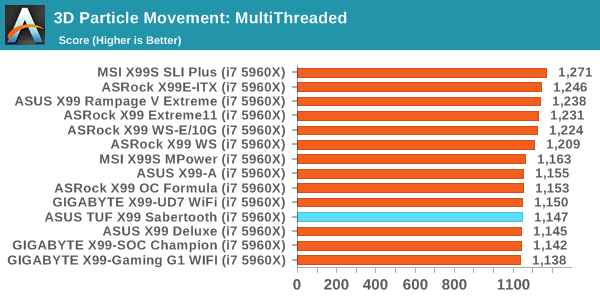
Compression – WinRAR 5.0.1: link
Our WinRAR test from 2013 is updated to the latest version of WinRAR at the start of 2014. We compress a set of 2867 files across 320 folders totaling 1.52 GB in size – 95% of these files are small typical website files, and the rest (90% of the size) are small 30 second 720p videos.
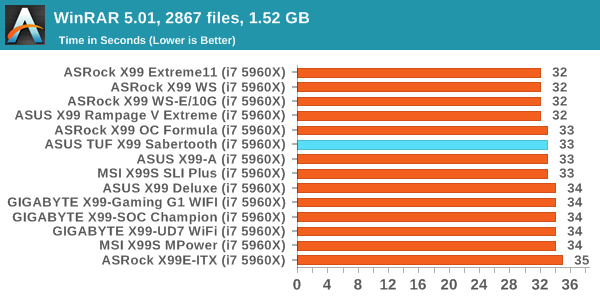
Image Manipulation – FastStone Image Viewer 4.9: link
Similarly to WinRAR, the FastStone test us updated for 2014 to the latest version. FastStone is the program I use to perform quick or bulk actions on images, such as resizing, adjusting for color and cropping. In our test we take a series of 170 images in various sizes and formats and convert them all into 640x480 .gif files, maintaining the aspect ratio. FastStone does not use multithreading for this test, and thus single threaded performance is often the winner.
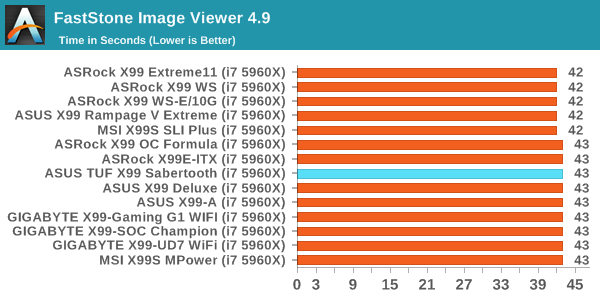
Video Conversion – Handbrake v0.9.9: link
Handbrake is a media conversion tool that was initially designed to help DVD ISOs and Video CDs into more common video formats. The principle today is still the same, primarily as an output for H.264 + AAC/MP3 audio within an MKV container. In our test we use the same videos as in the Xilisoft test, and results are given in frames per second.
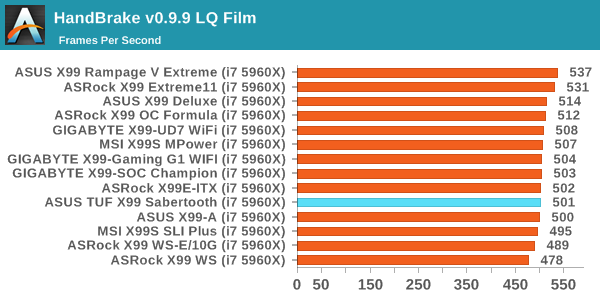

Rendering – PovRay 3.7: link
The Persistence of Vision RayTracer, or PovRay, is a freeware package for as the name suggests, ray tracing. It is a pure renderer, rather than modeling software, but the latest beta version contains a handy benchmark for stressing all processing threads on a platform. We have been using this test in motherboard reviews to test memory stability at various CPU speeds to good effect – if it passes the test, the IMC in the CPU is stable for a given CPU speed. As a CPU test, it runs for approximately 2-3 minutes on high end platforms.

Synthetic – 7-Zip 9.2: link
As an open source compression tool, 7-Zip is a popular tool for making sets of files easier to handle and transfer. The software offers up its own benchmark, to which we report the result.
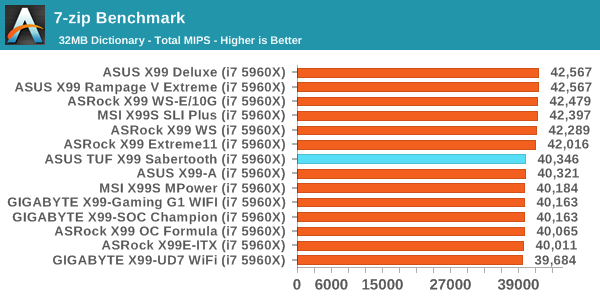










57 Comments
View All Comments
OldCOP - Tuesday, September 8, 2015 - link
that would also kill real advances in overclocking theory. Overclocking is not for someone who does not know what he is doing. If you must rely on "built in protection" you don't need to be overclocking.OldCOP - Tuesday, September 8, 2015 - link
It's the guns fault, not the NOOB that pulled the trigger ! Right? People need to take responsibility for what THEY do and stop blaming the manufacturer.Stuka87 - Wednesday, July 22, 2015 - link
He said how to get to the source (but has since now posted it).I find it pretty awesome that you were running X99 boards before they even started development on them.
superflex - Wednesday, July 22, 2015 - link
ASUS sockpuppet in the House!Six X99 boards operating for years?
LMFAO.
Does ASUS pay you in Hot Pockets?
bigboxes - Wednesday, July 22, 2015 - link
It was pretty funny. SIX Asus X99 boards. LOLGothmoth - Friday, July 24, 2015 - link
6 boards working since late 2014 make ~5 years of use.Desired Username #3 - Sunday, January 17, 2016 - link
Literally how? Are you adding up the time that you've owned the boards?Gothmoth - Friday, July 24, 2015 - link
well m*r*n...im a 3d freelancer doing jobs for architects.you ever heard about renderfarms?
distributed renderings? no.. well then get a clue.
so yes i need six x99 boards because i need lots of memory for my 3d scenes.
all boatds are equipped with 64gb of memory... ist how i earn my living.
not that a boy like you, who lives in his parents basement, would know anything about work or having a job.
so keep on wanking....
Ryangadz - Friday, July 24, 2015 - link
Have you looked into a GPU setup to do renderings? I know 3d studio max does it maybe Maya too. Workflow into those programs might not be ideal for your process but it could certainly save you a lot of time and money.I've always run dual CPU setups since 2002 for this reason but a GPU can be several times faster than even a dual Xeon for global illumination and raytracing.
itsallgoode9 - Wednesday, July 29, 2015 - link
GPU renderers generally aren't as fast as you'd think for interior renderings. Many other things, they are blazing fast (products, vehicles etc) but generally not interiors.I do product renderings for a living using Maya with Octane Render (GPU) and they work super fast for that. I was playing around with some interior rendering the other day and holy cow the speed drop from my product renders is substantial.
All my render programs are unbiased though, so if there's a biased gpu program out there, it might work much faster but then you're losing a lot of photo realism using biased.